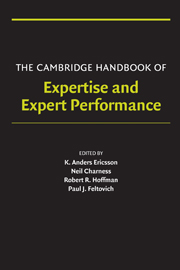Book contents
- Frontmatter
- Contents
- Acknowledgments
- Contributors
- PART I INTRODUCTION AND PERSPECTIVE
- PART II OVERVIEW OF APPROACHES TO THE STUDY OF EXPERTISE – BRIEF HISTORICAL ACCOUNTS OF THEORIES AND METHODS
- PART III METHODS FOR STUDYING THE STRUCTURE OF EXPERTISE
- PART IV METHODS FOR STUDYING THE ACQUISITION AND MAINTENANCE OF EXPERTISE
- PART V DOMAINS OF EXPERTISE
- PART V.A PROFESSIONAL DOMAINS
- 19 Expertise in Medicine and Surgery
- 20 Expertise and Transportation
- 21 Expertise in Software Design
- 22 Professional Writing Expertise
- 23 Professional Judgments and “Naturalistic Decision Making”
- 24 Decision-Making Expertise
- 25 The Making of a Dream Team: When Expert Teams Do Best
- PART V.B ARTS, SPORTS, & MOTOR SKILLS
- PART V.C GAMES AND OTHER TYPES OF EXPERTISE
- PART VI GENERALIZABLE MECHANISMS MEDIATING EXPERTISE AND GENERAL ISSUES
- Author Index
- Subject Index
- References
25 - The Making of a Dream Team: When Expert Teams Do Best
from PART V.A - PROFESSIONAL DOMAINS
- Frontmatter
- Contents
- Acknowledgments
- Contributors
- PART I INTRODUCTION AND PERSPECTIVE
- PART II OVERVIEW OF APPROACHES TO THE STUDY OF EXPERTISE – BRIEF HISTORICAL ACCOUNTS OF THEORIES AND METHODS
- PART III METHODS FOR STUDYING THE STRUCTURE OF EXPERTISE
- PART IV METHODS FOR STUDYING THE ACQUISITION AND MAINTENANCE OF EXPERTISE
- PART V DOMAINS OF EXPERTISE
- PART V.A PROFESSIONAL DOMAINS
- 19 Expertise in Medicine and Surgery
- 20 Expertise and Transportation
- 21 Expertise in Software Design
- 22 Professional Writing Expertise
- 23 Professional Judgments and “Naturalistic Decision Making”
- 24 Decision-Making Expertise
- 25 The Making of a Dream Team: When Expert Teams Do Best
- PART V.B ARTS, SPORTS, & MOTOR SKILLS
- PART V.C GAMES AND OTHER TYPES OF EXPERTISE
- PART VI GENERALIZABLE MECHANISMS MEDIATING EXPERTISE AND GENERAL ISSUES
- Author Index
- Subject Index
- References
Summary
The Making of a Dream Team: When Expert Teams Do Best
The original use of the phrase “Dream Team” was in reference to the US basketball team that won the gold medal at the 1992 Olympics in Barcelona. Team members included basketball greats (e.g., Michael Jordan, Magic Johnson, and Larry Bird) as well as Charles Barkley and seven more NBA All-Stars. This team of twelve proficient athletes who were at the top of their game seamlessly blended their talents such that they dominated the Olympic competition, beating their eight opponents by an average of 44 points.
On February 22, 1980 at the Olympic Winter Games in Lake Placid a highly skilled Russian hockey team, recognized as the best hockey team in the world, lost 4–3 to a young but skilled collegiate US hockey team. The US victory over the “undefeatable” Russian team in the semi-finals, whom they had just lost to 10–3 a week before in an exhibition match, put the US team in contention for the gold medal. The US hockey team, which had been seeded seventh in the 12-team tournament, went on to beat Finland (4–2) for the gold medal.
So what distinguishes these two teams from other teams? Teamwork? Individual expertise? Both? What led the original “Dream Team” to dominate the 1992 Olympics? Conversely, what led the star Russian team to lose to a team they had dominated only a week before?
- Type
- Chapter
- Information
- The Cambridge Handbook of Expertise and Expert Performance , pp. 439 - 454Publisher: Cambridge University PressPrint publication year: 2006
References
- 48
- Cited by

